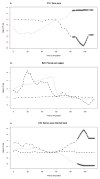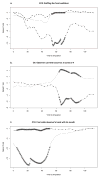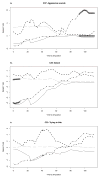Mapping Loci for fox domestication: deconstruction/reconstruction of a behavioral phenotype
- PMID: 21153916
- PMCID: PMC3076541
- DOI: 10.1007/s10519-010-9418-1
Mapping Loci for fox domestication: deconstruction/reconstruction of a behavioral phenotype
Abstract
During the second part of the twentieth century, Belyaev selected tame and aggressive foxes (Vulpes vulpes), in an effort known as the "farm-fox experiment", to recapitulate the process of animal domestication. Using these tame and aggressive foxes as founders of segregant backcross and intercross populations we have employed interval mapping to identify a locus for tame behavior on fox chromosome VVU12. This locus is orthologous to, and therefore validates, a genomic region recently implicated in canine domestication. The tame versus aggressive behavioral phenotype was characterized as the first principal component (PC) of a PC matrix made up of many distinct behavioral traits (e.g. wags tail; comes to the front of the cage; allows head to be touched; holds observer's hand with its mouth; etc.). Mean values of this PC for F1, backcross and intercross populations defined a linear gradient of heritable behavior ranging from tame to aggressive. The second PC did not follow such a gradient, but also mapped to VVU12, and distinguished between active and passive behaviors. These data suggest that (1) there are at least two VVU12 loci associated with behavior; (2) expression of these loci is dependent on interactions with other parts of the genome (the genome context) and therefore varies from one crossbred population to another depending on the individual parents that participated in the cross.
Figures






References
-
- Albert FW, Carlborg O, Plyusnina I, Besnier F, Hedwig D, Lautenschläger S, Lorenz D, McIntosh J, Neumann C, Richter H, Zeising C, Kozhemyakina R, Shchepina O, Kratzsch J, Trut L, Teupser D, Thiery J, Schöneberg T, Andersson L, Pääbo S. Genetic architecture of tameness in a rat model of animal domestication. Genetics. 2009;182(2):541–54. - PMC - PubMed
-
- Gácsi M, Miklósi A, Varga O, Topál J, Csányi V. Are readers of our face readers of our minds? Dogs (Canis familiaris) show situation-dependent recognition of human’s attention. Anim Cogn. 2004;7(3):144–53. - PubMed
-
- Gácsi M, Gyori B, Miklósi A, Virányi Z, Kubinyi E, Topál J, Csányi V. Species-specific differences and similarities in the behavior of hand-raised dog and wolf pups in social situations with humans. Dev Psychobiol. 2005;47(2):111–22. - PubMed
-
- Gilbert JR, Vance JM. Current Protocols in Human Genetics. John Wiley and Sons; New York: 1994. Isolation of genomic DNA from mammalian cells; pp. 1–6. Appendix A.3B.
Publication types
MeSH terms
Grants and funding
LinkOut - more resources
Full Text Sources

